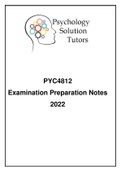PYC4812
Examination Preparation Notes
2022
, PYC4812 – SPORTS PSYCH. EXAM PREP
PART 1: LEARNING, MOTIVATION AND SOCIAL INTERACTION
CHAPTER 1
Brief overview of motor learning:
• Set of internal processes associated with practice or experience, leading to
permanent changes in in the capability for skilled movement behavior
• Cannot measure it (internal) but we can draw inferences from performance
(e.g.: improvements made)
• Phases
➢ Cognitive phase: learning, developing. Coach helps to teach. Duration differs
depending on what the athlete is learning
➢ Associative phase: Refinement, movements become more automated
(dribbling ball without looking – proprioceptive). Coach will help by designing
appropriate practices to help refine the skill. Duration is much longer than the
first phase. (Not all athletes will move past this phase)
➢ Autonomous phase: when the athlete can perform the skill at maximum
proficiency. Skill is very well developed; athletes can therefore focus on other
things apart from their movement. Coach can help by giving instruction to help
maintain and motivate athlete to continue improving
• Correcting errors
➢ Will depend on the severity of the change needed – slight changes, easier to
learn and require less practice
➢ More severe changes require the athlete to return to the cognitive phase of
learning and progress through various stages
➢ Process of relearning is intensive and will impact performance initially
➢ Major changes should take place during off-season
Error identification and diagnosis (Skill analysis)
• Observation
➢ Compare athlete’s technique with correct technique
➢ Determine if the basic movement is sound, don’t focus on smaller details
,• Determine the cause of errors (not always related to technique)
➢ Technique
➢ Physiological differences
➢ Inaccurate or delayed decision making
➢ Drill design (make sure it is developmentally appropriate)
➢ Psychological factors
• Once the error is identified: feedback
➢ First correct the most fundamental error, which will often be associated with
skills fundamental movement
➢ Often, once this is corrected, other errors will correct themselves as they have
happened as a result of the basic movement being incorrect
➢ Coach may also choose to correct the error that occurs earliest in the
movement (e.g.: diving board for diver), eliminating errors that occurred later
on in the sequence as a result of this initial problem
➢ Where there are unrelated errors, start with the easiest correction – this will
most likely lead to success hence helping motivate the athlete to continue
making improvements
Intervention strategies: feedback
• Provision of feedback: essential for motor skill acquisition
• Provides all the info: how to correct, explain errors (why they occur), motivate
• Feedback will hinder or enhance depending on timing, frequency, amount and
precision
• At first, when learning the skill, the athlete will require more feedback
• Feedback should lessen as skills become more refined
➢ Avoid athletes becoming accustomed to receiving feedback
o Rather than evaluating response-produced sensory information,
they will wait for the coach to tell them what they did/how to fix it
o Creates a passive learner, hinders performance when they do
not receive feedback such as during competition
➢ Methods for reducing feedback:
1. Faded feedback: feedback reduces as athlete refines their skill
, 2. Bandwidth: coach has an acceptable error tolerance, and will only
provide feedback when performance falls outside of this range.
Advantage: depends on the athletes’ actual performance, not some
arbitrary fixed schedule feedback session
3. Learner-regulated: feedback only given when the athlete requests it.
Thought to benefit from being actively involved in process
• Promote active learning: encourage athlete to assess their performance
before telling them what was observed
➢ Ask: if they achieved their movement goal, follow up questions if ‘no’
➢ Questioning approach: promotes reflective thinking, facilitates athlete’s
problem-solving skills
• Good feedback:
➢ Encourages learners to explore a variety of movement solutions allowing for
the discovery of the optimal pattern suited for that particular learner
➢ Focus on one correction at a time
➢ Positive, short, simple
➢ Matches the developmental level of the learner (it is not too hard, or too easy)
➢ Should have an external focus as opposed to internal focus (prompt to focus
on the effects of their actions on the environment) eg: instead of telling
sprinter to increase the turnover of their leg action to increase speed, they
could be told to minimize the ground contact
o the latter description is less likely to impact their natural flow of
movement.




